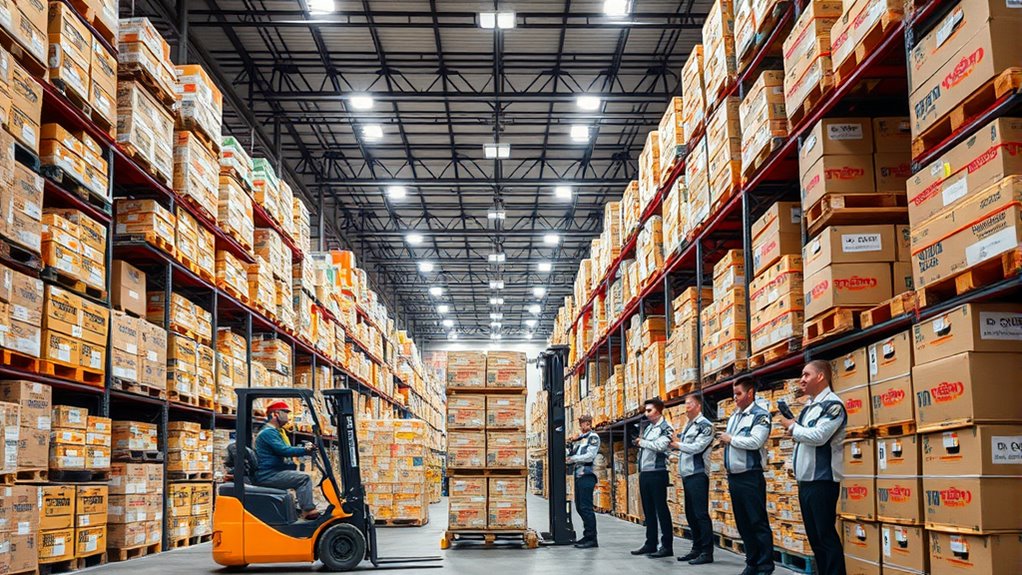To coordinate vendor deliveries and supplies effectively, you should maintain clear communication and build strong relationships with your vendors. Use technology to get real-time updates on stock levels and delivery schedules. Align delivery times with your inventory needs to avoid congestion and delays. Regularly review vendor performance and be flexible to make adjustments when necessary. Focusing on these strategies helps streamline your supply chain—keep exploring to discover even more ways to optimize your process.
Key Takeaways
- Establish clear communication channels with vendors to share schedules, expectations, and updates regularly.
- Implement integrated inventory management systems that sync with vendor delivery schedules.
- Use real-time tracking tools to monitor shipment statuses and adjust plans proactively.
- Coordinate delivery times with inventory needs to prevent congestion and ensure timely stock replenishment.
- Build strong vendor relationships to facilitate flexible scheduling and quick adjustments during disruptions.

Efficient vendor deliveries and supplies are indispensable for keeping your operations running smoothly. When you manage your supply chain effectively, you minimize delays, reduce stock shortages, and guarantee that your business can meet customer demands without hiccups. Central to this process is solid inventory management, which involves tracking stock levels accurately, forecasting needs, and maintaining the right amount of inventory to avoid overstocking or understocking. A well-organized inventory system allows you to anticipate when supplies are running low and act proactively, preventing disruptions that can hinder productivity.
Effective inventory management minimizes delays and stock shortages, ensuring smooth operations and meeting customer demands reliably.
Delivery scheduling plays a vital role in this equation. By coordinating delivery times with your inventory needs, you can streamline the flow of goods into your facility. When you schedule deliveries thoughtfully, you avoid congestion during peak hours, reduce wait times, and guarantee that your receiving area isn’t overwhelmed. It’s important to communicate clearly with your vendors to establish reliable delivery windows, especially if you work with multiple suppliers. Consistent delivery schedules help you plan your inventory replenishment, minimize idle stock, and keep your workspace organized.
Using technology can considerably enhance your ability to coordinate deliveries and manage inventory efficiently. Implementing inventory management software gives you real-time insights into stock levels, enabling you to plan orders more accurately and avoid emergency restocks. Many systems also offer features for scheduling deliveries, which can sync with your vendors’ systems to automate the process. This reduces manual errors and helps you stay on top of your supply chain. Furthermore, digital tools help you analyze delivery performance, identify bottlenecks, and refine your scheduling strategies over time.
Establishing a good relationship with your vendors is equally important. When you communicate your needs clearly and consistently, vendors can better align their delivery schedules with your operational rhythms. Building trust encourages vendors to prioritize your orders and accommodate any adjustments you might need. Always keep open lines of communication about delivery expectations, potential delays, or changes in demand. This proactive approach allows you to adjust your inventory management strategies promptly, avoiding surprises that could disrupt your workflow.
In addition, understanding the cultural and psychological aspects of your vendors can help foster better collaboration and ensure smoother supply chain operations. When you communicate your needs clearly and consistently, vendors can better align their delivery schedules with your operational rhythms. Building trust encourages vendors to prioritize your orders and accommodate any adjustments you might need. Always keep open lines of communication about delivery expectations, potential delays, or changes in demand. This proactive approach allows you to adjust your inventory management strategies promptly, avoiding surprises that could disrupt your workflow.
In the end, successful coordination of vendor deliveries and supplies hinges on your ability to plan meticulously, leverage technology, and foster strong vendor relationships. When you manage delivery scheduling effectively and keep a close eye on inventory levels, you’ll create a resilient supply chain that supports your business’s growth and stability. By staying organized and communicative, you’ll guarantee that your supplies arrive on time, your inventory remains balanced, and your operations stay efficient.
Frequently Asked Questions
How Can I Handle Last-Minute Delivery Changes Effectively?
When faced with last-minute delivery changes, you should stay calm and communicate promptly with vendors to confirm new delivery details. Make inventory adjustments as needed to account for the changes, and implement your contingency planning to minimize disruptions. Keep all stakeholders informed and flexible, so you can adapt quickly. Building strong vendor relationships also helps guarantee smoother adjustments and faster resolutions during unexpected delivery shifts.
What Are Best Practices for Tracking Multiple Vendor Shipments?
To track multiple vendor shipments effectively, you should rely on robust inventory tracking systems that provide real-time updates. Always verify order confirmation details with each vendor to guarantee accuracy. Use centralized platforms or spreadsheets to monitor shipment statuses, deadlines, and delivery dates. Regularly communicate with vendors to address issues promptly. This approach helps you stay organized, reduces errors, and ensures timely deliveries, keeping your supply chain smooth and efficient.
How Do I Manage Vendor Communication During Delays?
Your vendor communication during delays can feel like steering a maze with no end in sight. Stay proactive by informing vendors of the issue immediately, emphasizing the importance of their performance and delivery scheduling. Keep records of all updates and ask for revised timelines. Regular check-ins build trust and help manage expectations. Clear, prompt communication ensures you maintain control and minimize disruptions, even when delays threaten to throw everything off course.
What Technology Tools Assist in Coordinating Deliveries?
You can use technology tools like inventory management software and supply chain visibility platforms to coordinate deliveries effectively. These tools give you real-time updates on stock levels and shipment statuses, helping you anticipate delays and adjust schedules promptly. By integrating these systems, you gain better control over your supply chain, improve communication with vendors, and guarantee smoother delivery processes. This proactive approach minimizes disruptions and keeps your inventory well-managed.
How Can I Improve Vendor Relationship Management for Timely Supplies?
Oh, sure, because a “loving” vendor relationship is just about sending endless emails, right? Actually, you can enhance vendor management by regularly evaluating vendors through performance reviews, focusing on reliability and communication. Foster supply chain collaboration by sharing forecasts and feedback openly. Building trust and transparency helps guarantee timely supplies, turning vendors into partners rather than mere service providers. Remember, a good relationship saves you from last-minute surprises!
Conclusion
By carefully coordinating vendor deliveries and supplies, you create a smoother, more harmonious operation. When you approach this task with a gentle touch and a positive mindset, it becomes a rewarding dance rather than a stressful chore. Embrace the rhythm of collaboration, and you’ll find that even potential hiccups become opportunities for growth. With patience and a friendly approach, you’ll foster strong relationships and guarantee everything flows seamlessly, making your day a little brighter and your work a lot easier.









